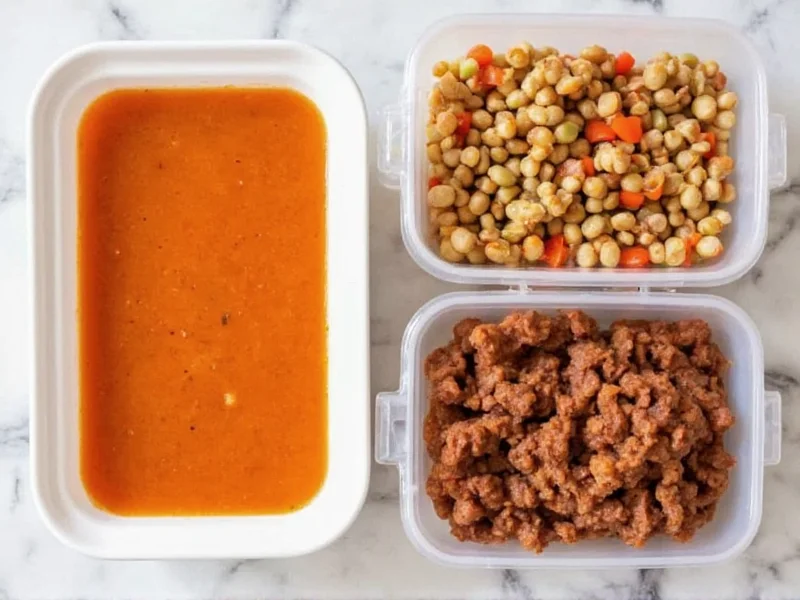Choosing the right container for freezing soup isn't just about convenience—it directly impacts flavor preservation, texture retention, and food safety. The wrong container can lead to freezer burn, cracked vessels, or chemical leaching, compromising your carefully prepared broth. After testing dozens of options across multiple freezing cycles, we've identified which materials maintain soup quality longest while fitting practical kitchen needs.
Top 5 Container Types for Freezing Soup Compared
| Container Type | Best For | Max Storage Time | Space Efficiency | Key Consideration |
|---|---|---|---|---|
| Tempered Glass | Short-term (1-2 months), flavor preservation | 2 months | Moderate | Requires 1-1.5" headspace for expansion |
| BPA-Free Plastic | Everyday use, durability | 3 months | Moderate | Look for "freezer-safe" symbol |
| Freezer Bags (Laid Flat) | Long-term storage, space saving | 6 months | Excellent | Prevents ice crystals when flat |
| Vacuum Seal Containers | Long-term (6+ months), preventing freezer burn | 12+ months | Good | Highest initial cost |
| Mason Jars (Wide-Mouth) | Broth-based soups, eco-friendly | 4 months | Poor | Must leave 2" headspace, store upright |
Material Safety Considerations for Frozen Soup
Not all containers labeled "microwave-safe" or "dishwasher-safe" withstand freezing temperatures. When evaluating options for best containers for freezing soup, prioritize materials with these properties:
- Glass containers should be specifically tempered for freezer use—regular glass often cracks due to liquid expansion. Anchor Hocking and Pyrex make freezer-safe options with secure lids.
- Plastic containers must be BPA-free and display the snowflake/freezer symbol. Avoid containers not explicitly rated for freezing, as low temperatures can cause chemical leaching.
- Silicone containers offer flexibility for expansion but require rigid outer storage to maintain shape. Stasher bags provide a reusable alternative to disposable freezer bags.
Never use containers originally holding non-food items (like yogurt tubs or margarine containers), as their plastic composition isn't designed for repeated freezing cycles. These often become brittle and may leach chemicals into acidic soups like tomato-based varieties.
Space-Saving Techniques for Freezer Organization
Maximizing freezer space while preserving soup quality requires strategic container selection. For those seeking space-saving soup storage containers, consider these approaches:
Laying freezer bags flat creates stackable "soup bricks" that fit efficiently in freezer drawers. Once frozen solid (about 24 hours), you can stand them upright like books on a shelf. This method uses 40% less space than rigid containers while allowing quick portion access.
For meal preppers freezing multiple batches, portion soup into muffin tins, freeze until solid, then transfer the portions to a single large freezer bag. This how to freeze soup without freezer burn technique creates ready-to-use single servings that thaw in under 15 minutes.
Avoiding Common Freezing Mistakes
Even with the best freezer containers for soup, improper technique causes quality issues. These critical errors undermine your efforts:
- Insufficient headspace—Liquid expands 9% when frozen. Without 1-1.5" clearance, containers crack or lids blow off.
- Freezing hot soup—Always cool soup to 70°F (21°C) first. Hot contents raise freezer temperature, partially thawing other items.
- Poor labeling—Use waterproof labels with contents and date. Most soups exceed peak quality after 3 months.
- Ignoring fat separation—Stir cream-based soups after thawing, as fats separate during freezing.
For creamy or pureed soups prone to texture changes, add a stabilizer like 1 tsp cornstarch per quart before freezing. This maintains consistency better than freezing plain.
Thawing and Reheating for Best Results
The container choice affects not just freezing but also reheating. Glass containers transition safely from freezer to microwave (remove lid first), while plastic requires thawing first. For containers that prevent freezer burn with vacuum sealing, simply submerge the sealed bag in cold water for 30 minutes before reheating.
Always thaw soup in the refrigerator overnight for food safety—never at room temperature. When reheating, bring to 165°F (74°C) minimum to eliminate any bacteria growth during thawing. Stir frequently for even heating, especially with chunky vegetable soups.
FAQs About Freezing Soup Containers
Can I freeze soup in regular plastic containers?
No, standard plastic containers not labeled "freezer-safe" become brittle and may crack or leach chemicals when frozen. Only use containers with the snowflake/freezer symbol, which indicates they're made from polypropylene (PP#5) designed for freezing temperatures. Yogurt tubs and takeout containers should never be reused for freezing soup.
How do I prevent freezer burn on frozen soup?
Prevent freezer burn by eliminating air exposure. For rigid containers, fill to 1-1.5" below the rim and place parchment paper directly on the soup surface before sealing. For bags, squeeze out all air and lay flat to freeze. Vacuum-sealed containers provide the best protection for storage beyond 3 months. Always label with dates—most soups maintain quality for 2-3 months in standard containers.
Are glass containers better than plastic for freezing soup?
Glass containers preserve flavor better and don't absorb odors, making them ideal for best containers for freezing soup when flavor integrity matters. However, they're heavier, take more space, and require careful handling to prevent breakage from expansion. Use only tempered glass with straight sides (no shoulders) and leave adequate headspace. Plastic containers offer better space efficiency and durability for long-term freezer storage.
What's the best way to freeze large batches of soup?
For large batches, portion soup into 1-2 cup servings using flat-laying freezer bags or vacuum seal containers. This how to properly freeze soup method allows you to thaw only what you need. Freeze bags flat on baking sheets first, then stack upright. Label each with contents and date. For immediate use within 2 months, BPA-free plastic containers work well; for longer storage, vacuum sealing extends quality to 12+ months.











 浙公网安备
33010002000092号
浙公网安备
33010002000092号 浙B2-20120091-4
浙B2-20120091-4